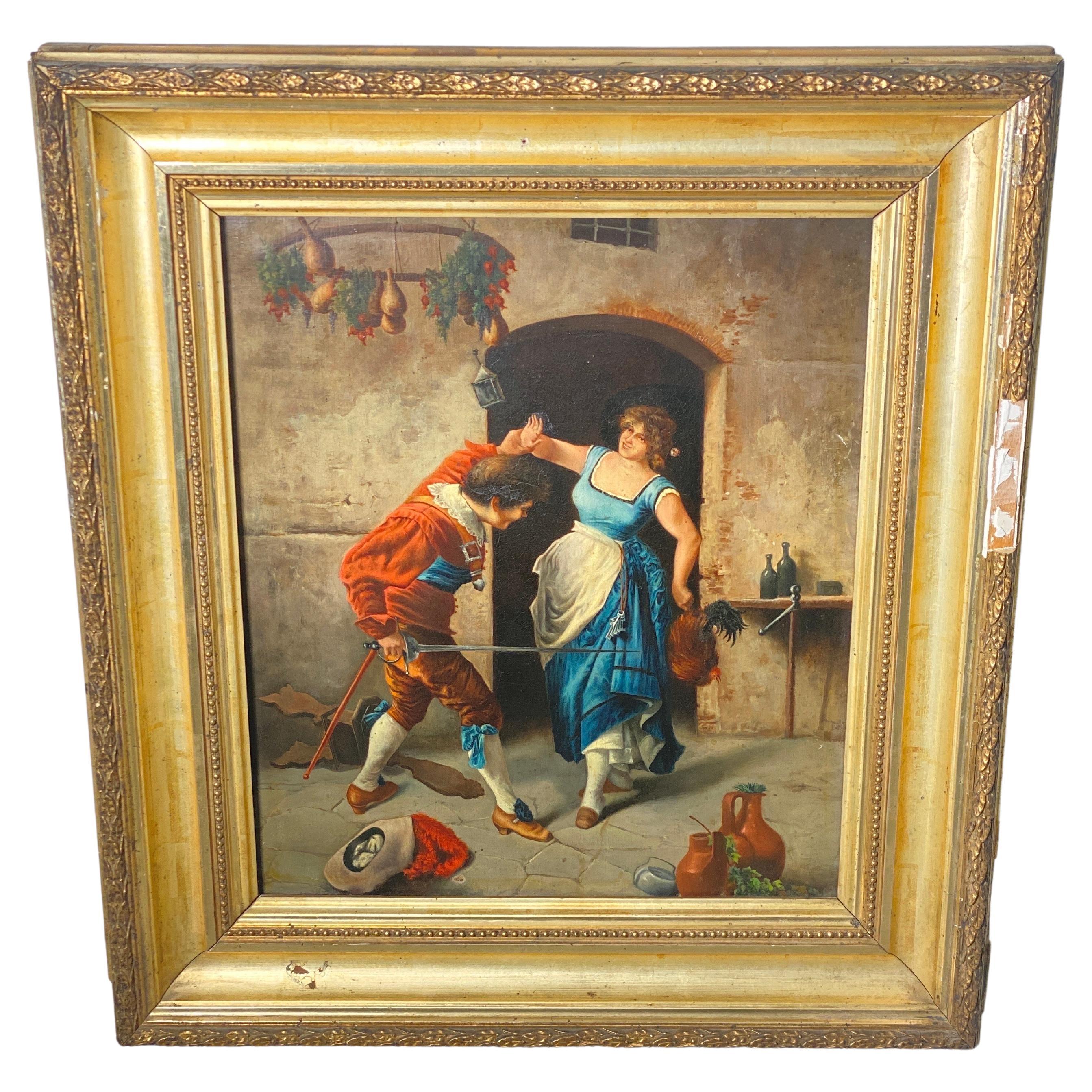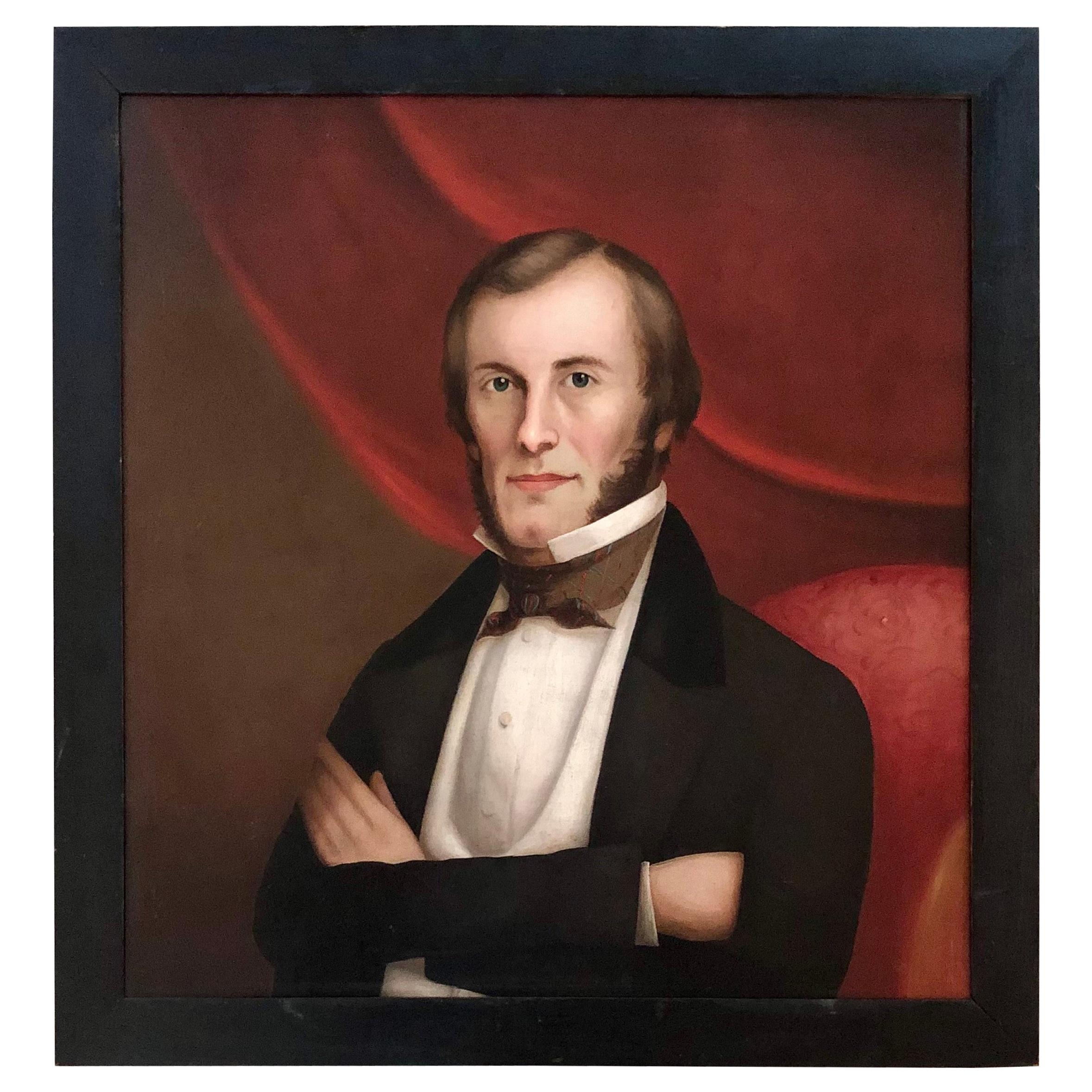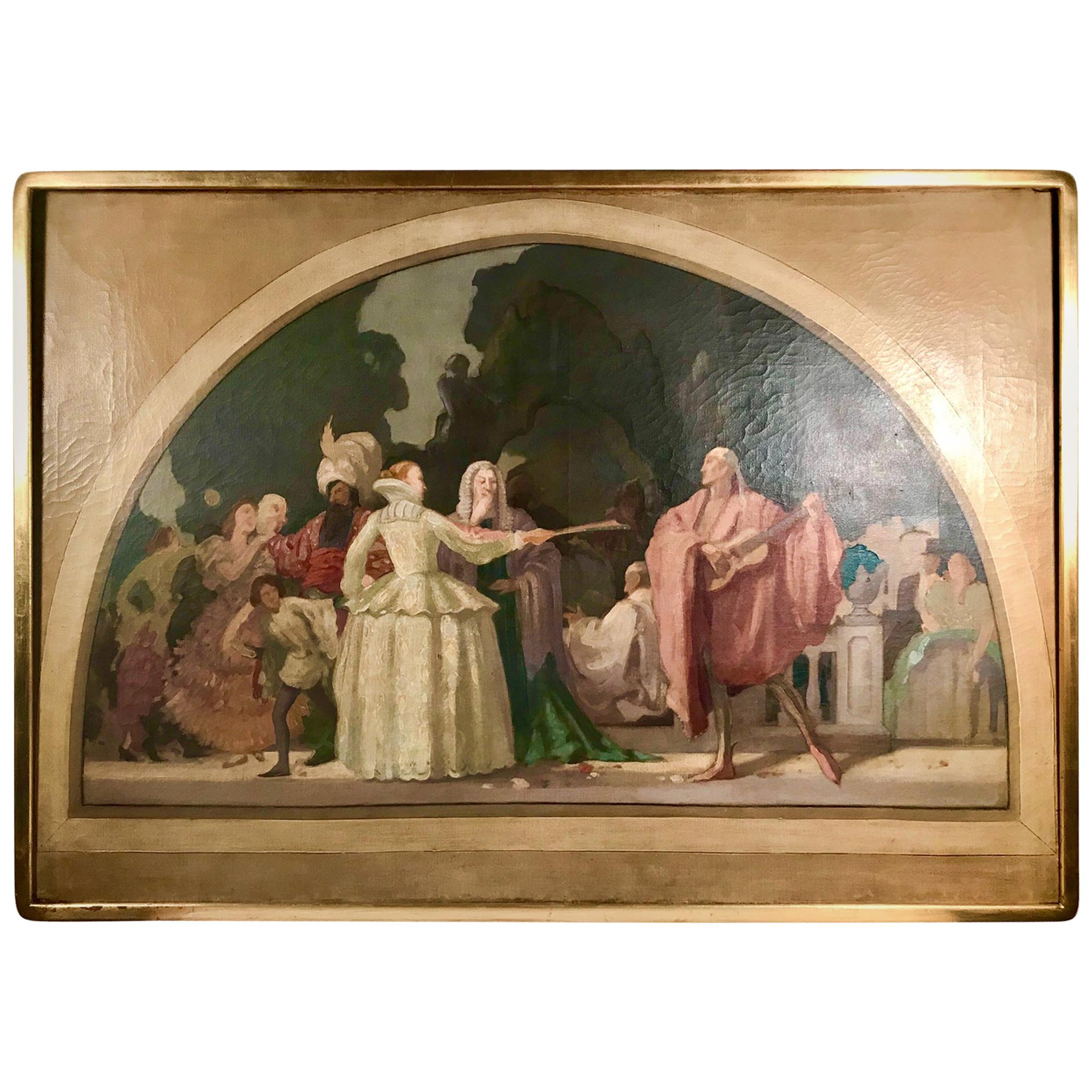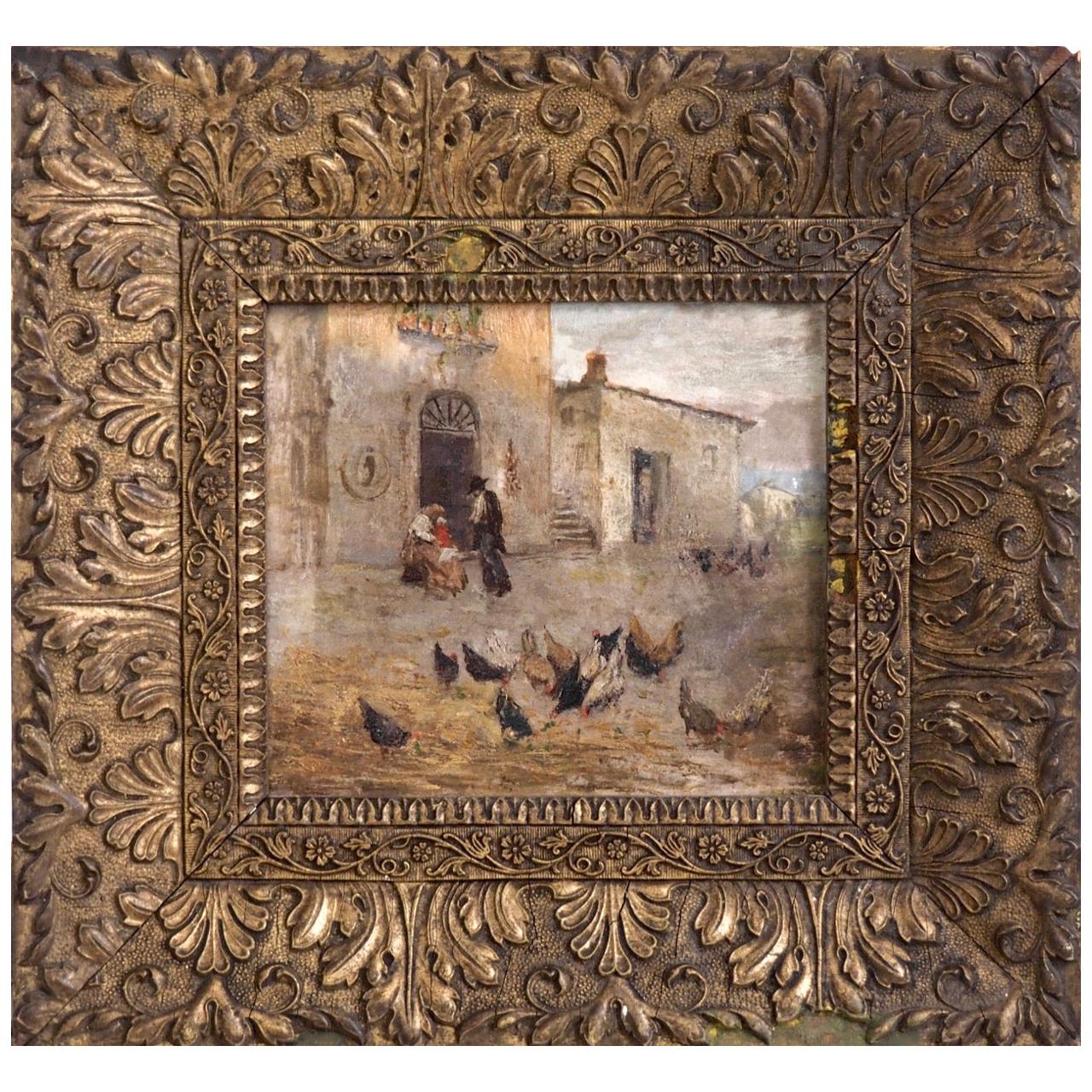Items Similar to 19th Century Italian Painting Attributed to Silvestro Lega
Want more images or videos?
Request additional images or videos from the seller
1 of 10
19th Century Italian Painting Attributed to Silvestro Lega
About the Item
Beautiful painting on panel depicting a young lady with headdress attributed to Silvestro Lega.
It bears the inscription ‘Lega -78-’ on the back.
Oil on panel
NB The painting is sold without frame
Each item in our Gallery upon request is sold accompanied by a certificate of authenticity issued by Sabrina Egidi Expert of the Court and C.C.I.A. of Rome.
This item comes from a private collection and is therefore unprecedented on the market.
Professional packaging insured Worldwide shipping by DHL For further information egidimadeinitaly
Silvestro Lega (8 December 1826 – 21 September 1895) was an Italian realist painter.
He was one of the leading artists of the Macchiaioli and was also involved with the Mazzini movement.
He was born in Modigliana, near Forlì, to an affluent family.
From 1838 he attended the Piarist College, where his skill at drawing became evident.
From 1843 to 1847 he attended the Accademia di Belle Arti, Florence, studying drawing under under Benedetto Servolini (1805–79) and Tommaso Gazzarrini (1790–1853), then studying painting, briefly, under Giuseppe Bezzuoli.
During 1847 he attended Luigi Mussini’s school, where the teaching emphasized the 15th-century Florentine principles of drawing and orderly construction.
Then and for some years afterwards he continued to attend the Scuola del Nudo of the Accademia.
As a Garibaldian volunteer, Lega participated in the military campaigns for Italian independence (1848–49) before resuming his training, this time under Antonio Ciseri. In 1850 he completed his first large-scale painting, Doubting Thomas (Modigliana, Osp. Civ.). In 1852 he won the Concorso Trienniale dell’Accademia with David Placating Saul.
On 30 January 1853, he became a member of the Accademia degli Incamminati of Modigliana.
In 1855, Lega returned to his native town, where he remained until 1857. Serious by nature, Lega was an infrequent visitor of the Caffè Michelangiolo, a favorite meeting place in the 1850s for the young painters who later became known as the Macchiaioli.
Diego Martelli, a contemporary of Lega, wrote of him that "he was not one of those people who, artistically speaking, can fling themselves into novel developments .... In spite of the discussions that went on nightly in the crucible of the Caffè Michelangiolo, Lega's art, until 1859, remained conspicuously academic."Subsequently, Lega's style began moving towards Realism and away from the Purismo of Mussini.
This progress is evident in the four lunettes he painted between 1858 and 1863 for the Oratory of the Madonna del Cantone in Modigliana, and in several military-themed works he painted during that period.
Together with his Macchiaioli friends Odoardo Borrani, Giuseppe Abbati, Telemaco Signorini and Raffaello Sernesi, he started painting landscapes en plein air.
From 1861 to 1870, he lived with the Batelli family, near the Affrico river, and started a relationship with the elder daughter, Virginia.
The children and women of the Batelli family were the subjects of many of his paintings during this happy period of his life. In 1870, he was awarded the silver medal at the Parma's National Exposition.
In that same year, Virginia Batelli, his companion, died of tuberculosis. Three of Lega's brothers also died at about this time. The grieving Lega returned to Modigliana.
Depressed, and experiencing the onset of eye problems, he ceased painting almost entirely for four years between 1874 and 1878. In 1875, he and Borrani established a modern art gallery in Florence, but it quickly failed, and Lega's financial problems worsened.
In 1878 he took part in the preparations for the Paris Universal Exposition. At the Florentine Promotrice in 1879, Lega—who never traveled outside Italy—saw two Impressionist paintings by Camille Pissarro, which he admired. He became a frequent guest of the Tommasi family, and a tutor of the sons of the family.
The art historian Norma Broude says that "like the Batellis before them, [the Tommasis] welcomed Lega into their family circle and provided for him the warm and close-knit family environment in which he and his art could flourish.
In 1886, he painted one of his most famous works, the Gabbarigiane. By the mid-1880s, Lega was almost blind, and perceived only large masses.
He produced many paintings in Gabbro, where he was a guest of the Bandini family. He participated at the Exposition Universelle (1889) and at the Promotrice of Florence.
This artwork is shipped from Rome. Under existing legislation, any artwork in Italy created over 70 years ago by an artist who has died can requires a license for export regardless of the work’s market price. The shipping may require additional handling days to require the license according to the destination of the artwork.
- Attributed to:Silvestro Lega (Artist)
- Dimensions:Height: 11.03 in (28 cm)Width: 7.49 in (19 cm)Depth: 0.2 in (5 mm)
- Style:Romantic (Of the Period)
- Materials and Techniques:
- Place of Origin:
- Period:
- Date of Manufacture:1878
- Condition:Wear consistent with age and use. Minor fading.
- Seller Location:Roma, IT
- Reference Number:1stDibs: LU4827239658422
About the Seller
5.0
Vetted Seller
These experienced sellers undergo a comprehensive evaluation by our team of in-house experts.
Established in 2005
1stDibs seller since 2019
72 sales on 1stDibs
Typical response time: 1 hour
- ShippingRetrieving quote...Ships From: Rome, Italy
- Return PolicyA return for this item may be initiated within 14 days of delivery.
More From This SellerView All
- 19th Century Enrico Coleman Signed PaintingBy Enrico ColemanLocated in Roma, ITAn important painting by one of the most representative Italian artists of the 19th century, Enrico Coleman. It depicts a village most probably from Lazio, perhaps a glimpse of Anticoli Corrado, the town famous for the attractiveness of its models, or rather Subiaco, his mother's birthplace. The atmosphere here is typical of the XXVs of the Roman Campagna of which Enrico Coleman was probably the most important exponent. The reason for this can also be seen in this small masterpiece that captures the washerwomen in their occupation immersed in a poetically bucolic atmosphere; a sky of unparalleled blue stands out in the background. Signed below on the right This painting, never before on the market, comes from an important Italian private collection and is beautified by an impressive antique frame in gilded wood, in almost perfect condition. Every item of our Gallery, upon request, is accompanied by a certificate of authenticity issued by Sabrina Egidi official Expert in Italian furniture for the Chamber of Commerce of Rome and for the Rome Civil Courts. Oil painting on paper Enrico Coleman (21 or 25 June 1846 – 14 February 1911) was an Italian painter of British nationality. He was the son of the English painter Charles Coleman and brother of the less well-known Italian painter Francesco Coleman. He painted, in oils and in watercolours, the landscapes of the Campagna Romana and the Agro Pontino; he was a collector, grower and painter of orchids. Because of his supposedly Oriental air, he was known to his friends as "Il Birmano", the Burmese. Enrico Coleman was born in Rome in June 1846. He was the fourth child of the English painter Charles Coleman, who had come to Rome in 1831 and settled there permanently in 1835, and of a famous artist's model from Subiaco, Fortunata Segadori (or Segatori), whom he had married in 1836. Coleman was initially taught by his father, did study at the Accademia di San Luca in Rome. Following the mocking reception of Una mandria di bufali nelle paludi pontine, a naturalistic painting of a herd of buffaloes in the Pontine marshes, at the International Artist's Club in 1872,he reportedly began to paint genre subjects in the manner of the then-fashionable Mariano Fortuny, although no works showing the influence of the Spanish painter are known. At the instigation of Nino Costa, he soon returned to the depiction of the people, animals and landscapes of the Campagna Romana and the Agro Pontino. Coleman was lover of orchids, which he painted, collected and cultivated. An 1894 watercolour of orchids is in the Galleria Comunale d'Arte Moderna e Contemporanea in Rome. Coleman had a remarkable collection of indigenous orchids, which he cultivated himself in his house at 6 via Valenziana and the botanist Fabrizio Cortesi named the hybrid Orchis x colemanii Cortesi in his honour. In 1875, Coleman was among the founding members of the Società degli Acquarellisti, the Roman society of watercolourists; he participated in the society's first exhibition in 1876, and continued to exhibit with them until 1907. In 1878 he was elected an honorary member of the Société Royale Belge des Aquarellistes, the Belgian royal society of watercolourists, with which he participated in the Salon de Paris in 1879 and to the 4th Esposizione Nazionale di Belle Arti, or national fine art show, of Turin in 1880, and to that of Milan in the following year; he showed works in London in 1882 and in Rome in 1883. In 1885, Coleman was among the founding members of the group In Arte Libertas, of which Nino Costa was the leading force and the other founding members were Vincenzo Cabianca...Category
Antique Late 19th Century Italian Grand Tour Paintings
MaterialsWool, Canvas, Paper
- Ruggero Panerai 19th Century Signed PaintingBy PaneraiLocated in Roma, ITAn important oil on panel painting by the great Tuscan artist Ruggero Panerai. It depicts one of his favourite and most successful subjects, wild horse...Category
Antique 1890s Italian International Style Paintings
MaterialsWood
- 19th Century Signed French Still LifeLocated in Roma, ITImportant painting "Still life" oil on canvas of the second half of the 800 by the great artist Aémile-Auguste Vivier-Deslandes called "Baron Deslandes". Of rare intensity and beauty...Category
Antique 1880s French Romantic Paintings
MaterialsCanvas
- Pair of 19th Century Rembrandt Follower PaintingBy Rembrandt van RijnLocated in Roma, ITPair of important oil paintings by a follower of Rembrant The two works represent two celebrated paintings : "The Anatomy Lesson of Dr. Nicolaes Tulp" and "The Sampling Officials." ...Category
Antique 1890s Italian Baroque Paintings
MaterialsWood
- Karel Klinkenberg 19th Century Dutch Signed PaintingBy Johannes Christiaan Karel KlinkenbergLocated in Roma, ITBeautiful and important painting by the great Dutch artist Karel Klinkenberg who lived at the turn of the 19th and 20th centuries. It depicts a canal in Utrecht depicted with his usual precision attentive to every detail. Another characteristic of our painter, is the evocative power of the romantic and gentle atmosphere he always manages to convey. Signed at lower left and signed and inscribed on the reverse. Johannes Christiaan Karel Klinkenberg (1852, The Hague – 1924, The Hague), was a 19th-century Dutch painter specialized in views of the town especially Amsterdam and Utrecht as our painting. Biography According to the RKD he was a pupil of Christoffel Bisschop (1828-1904) and Louis Meijer, and became a member of the Pulchri studio who later won many prizes. A street is named after him in the neighborhood of streets named after 19th and 20th century Dutch painters in Overtoomse Veld-Noord, Amsterdam. This painting, never before on the market, comes from a private collection Every item of our Gallery, upon request, is accompanied by a certificate of authenticity issued by Sabrina Egidi official Expert in Italian furniture for the Chamber of Commerce of Rome and for the Rome Civil Courts. This artwork is shipped from Rome. Under existing legislation, any artwork in Italy created over 70 years ago by an artist who has died can requires a license for export regardless of the work’s market price...Category
Antique Late 19th Century Dutch International Style Paintings
MaterialsCanvas
- 19th Century Neapolitan Panting by Carlo BrancaccioBy Carlo BrancaccioLocated in Roma, ITAn important painting by one of the greatest Italian artists of the 19th century, Carlo Brancaccio. He was one of the most important exponents of the Posillipo School and shows all h...Category
Antique Late 19th Century Italian Grand Tour Paintings
MaterialsCanvas, Wood
You May Also Like
- Genuine 19th Century Oil Painting, Italy, Attributed to Guiseppe GuzzardiLocated in Auribeau sur Siagne, FRGenuine oil Painting, attributed to Giuseppe Guzzardi. It has been painted in Italy Circa 1880. the frame is in wood gilted.Category
Antique 1880s Italian Paintings
MaterialsPaint
- 19th Century Painting Attributed to William Shayer Snr. 'British', 1787-1879By WILLIAM SHAYER SENIOR (1787-1879)Located in Dublin, IEArtist: William Shayer Senior (British) 1787 - 1879 Medium: Oil on canvas in original gilt frame Framed Size: H: 34 in / 86.3 cm ; W: 51 in / 129.5 cm Artists Biography: William Joseph Shayer senior was a self-taught artist, who began by painting decorations on rush-bottom chairs, and moved on to painting carriages in the town of Guildford, after which he started doing heraldic painting...Category
Antique 19th Century English Romantic Paintings
MaterialsCanvas, Giltwood
- 19th Century Oil on Canvas Painting Attributed to Eugenio Lucas VillamamilLocated in Marbella, ESAntique 19th century oil on canvas people painting attributed to Eugenio Lucas Villamamil, with acanthus and foliate gilt wood and gesso frame Dimensi...Category
Antique 19th Century Spanish Paintings
MaterialsCanvas
- 19th Century Folk Art Painting of a Gentleman Attributed to Horace BundyLocated in Wiscasset, MEOil on canvas, inscribed on the stretcher bar reverse. The painting is presented in a flat black frame that complements it well. Horace Bundy was an it...Category
Antique 1830s American Folk Art Paintings
MaterialsCanvas, Paint
- 19th Century French Painting Oil/Canvas Attributed to Pierre Puvis de ChavannesLocated in Vero Beach, FL19th century French painting oil/canvas attributed Pierre Puvis de Chavannes. Large preparatory study for a mural. It is painted in oil on canvas and it depicts a theatrical scene. De Chavannes’ greatest artistic contribution was the medium of mural painting. His biography states, “De Chavannes’ work proved a vital catalyst, as early modern art...Category
Antique Late 19th Century French Post-Modern Paintings
MaterialsCanvas
- Fine Italian Painting, 19th CenturyLocated in Aalsgaarde, DKFine Italian painting, unsigned and with original guilt frame, late 19th century.Category
Antique 19th Century Paintings
MaterialsPaint





